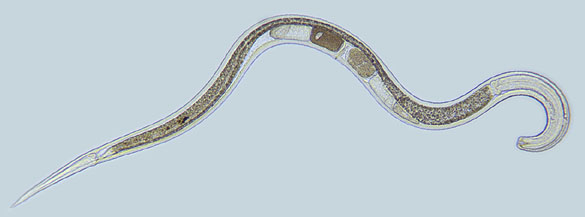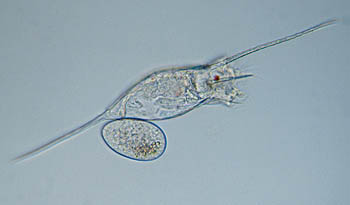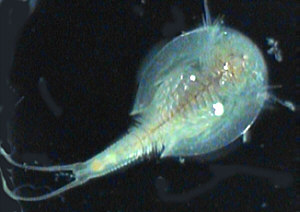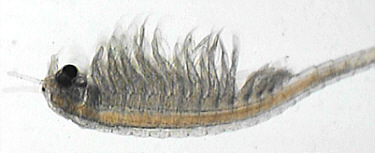|
|
The third and final journey text by Richard L.
Howey
|
 |
|
|
The third and final journey text by Richard L.
Howey
|
 |
Unbeknownst to you, Professor Moriarty and I planned an adventure quite different from the two previous ones. On those journeys, you had primarily encountered protists; on this one we wanted you to observe and record some of the multicellular fauna, but the Professor didn't want you to know in advance, since some of these organisms are not only gigantic relative to your reduced size, but potentially quite dangerous as well.
Fortunately, the first organisms you encounter are some fairly harmless nematodes which are worm-like creatures and look like pieces of thin spaghetti pointed at both ends and move like they were on a combination of steroids and methamphetamines, twisting and arching, back and forth endlessly. You soon tire of all this frenetic activity and swim off toward a small forest of algae. As you approach, you observe that this forest consists of long strands of filamentous algae which are oscillating, wriggling, moving! and since you still tend to think of algae as plants sometimes (in spite of the new five kingdom system of classification), you find the movement of these long tubes packed with chlorophyll, rather disconcerting.

A nematodeHowever, as you swim just above this freshwater kelp forest, one entrancing organism after another appears and you begin to relax and enjoy this journey even more than the two previous ones. A remarkably strange and yet lovely ciliate appears. It looks rather like an ovoid sphere with an elongated snout; it is Trachelius ovum. This elegant being does indeed look like a being from some future and alien world. It is almost completely transparent and looks like a blown glass structure with struts and skywalks and girders supporting this seemingly fragile envelope. I was delighted with your video of this organism as it is one of my all time favorites.
The second marvelous vision that floated past you above the filamentous forest was the rotifer, Kellicottia longispinus, the name of which, however, does not cause you to anticipate any marvels whatsoever, but there gliding above you is a Klingon warship with three enormously long spines at the anterior end and one even longer one at the posterior. A surprising feature of this organism is that it will sometimes lie motionless on the bottom of a culture dish, almost unnoticeable, and then suddenly extrude its "wheels" and begin a slow, ponderously graceful ascent. As you watch this strangely lovely creature, something much larger jets past you, leaving you bobbing in its wake. This very large creatures does a "U" turn and stops, facing you from a distance of only a few thousand microns. It looks like some sleek armored vehicle of extraordinarily dangerous aspect, since, in the middle of what one takes to be its head, is a brilliant red eyespot glistening like a ruby which looks as though it could emit a deadly laser beam. On each side near the posterior end is a large sac which is filled with eggs, each of which will hatch out into a strange looking little larva called a nauplius.

KellicottiaSuddenly we hear you cry out: "Oh my God. There is an absolutely gigantic, unbelievable horseshoe crab down here on the bottom!" Professor Moriarty gets on the microphone and said, "Don't be absurd. This is a freshwater culture. That's merely a Triops, a tadpole shrimp. Admittedly, it does bear a superficial resemblance to a horseshoe crab, but it's quite harmless. Don't be so childish."
"Listen, that's fine to say from where you are, but this thing is about 100 times my size and could easily crush me."
"Nonsense," said the Professor, that is a small one, barely half an inch long. Some of them are 2 1/2 inches long. Just swim over it and get some good video tape."

Triops (young adult)In spite of the Professor's nonchalance, Triops is a remarkably bizarre creatures. It does look rather like a miniature horseshoe crab, which itself has been described as a "living fossil". Triops tend to live in rather shallow temporary ponds and here in the high plains, there has to be enough runoff from the snow melt to fill these ponds for a few weeks. Sometimes these ponds will remain dry for several years and then there will be a spring when the conditions are just right and if you have the luck to time your collecting trip just right as well, you will have the opportunity to observe an extraordinary phenomenon. There is one muddy little pond only about 30 feet across and so shallow that the grass is growing up above the surface of the water and some years, this overgrown puddle will contain thousands of tadpole shrimp and fairy shrimp. Tadpole shrimp, fairy, shrimp, and clam shrimp all get lumped into a taxonomic category called Eubranchipoda. All three are exclusively freshwater and well worth hunting for.

Fairy shrimpFairy shrimp can get up to an inch and a half and are wonderful acrobats as they dance and glide through the water and seem to spend most of their time swimming on their backs as they feed. Tadpole shrimp, on the other hand, tend to burrow down in the loose mud and almost look like miniature sting rays. If you collect any of these wonderful creatures, take only what you can reasonably use. Take along an old thermos bottle or gallon jar and fill it only half full of water. Do not crowd the specimens as they must have plenty of space to move in order to obtain oxygen. Even under good conditions, it is likely that only about half of the organisms will make it back to the lab alive. Remove the dead ones immediately and preserve them for later study. Transfer the remainder to a small aquarium and add either filtered pond water or artesian water. In either case, pour about a third of the water in the container into the aquarium and then vigorously shake the remainder of the water to oxygenate it, then add it to the aquarium. change part of the water every few days and your Triops may last 2 weeks or more.
In the pond, the conditions can change very quickly and so both the fairy shrimp and the tadpole shrimp reproduce at an incredible rate producing highly resistant eggs that can survive both summer and winter down in the mud after the pond dries up which can happen in just a matter of a few days. The effort to observe these creatures alive takes a bit of time and care, but it is a special experience.

PlanariaBut back to the culture dish. The Triops catches your interest almost immediately and you relax and begin to describe its morphology and behavior. The Professor is rather annoyed by your calm attitude and before I can stop him, he decides to create a bit of excitement for you by introducing a Planaria from another culture. Almost everyone remembers news stories about the remarkable regenerative powers of the flatworm PlanariaŚcut one in half and you get two Planaria in a very short time. Make a series of cuts in the head and you can create a 7-headed monster which, as it turns out, is exactly what Moriarty did. When you saw this gigantic mutant, you moved faster than I had ever before observed and although I shouted a warning, it was too late. Your panic caused you to ignore everything, including that long green tubular structure which looked as though it was covered with thorns. As it moved directly toward you, one of the "thorns" brushed against your body, discharging a "spear" which impaled you. You had brushed against a nematocyst or "stinging cell" of a green hydraŚa stalk with tentacles armed with deadly weapons.
"Damn," said Moriarty. "I wanted him to go into a marine sample next time. Now you'll have to go in his place." At that point, I hit the professor very hard and he fell into the reduction chamber. After that he disappeared and no trace of him was ever found. I hope the hydra didn't get indigestion.
Comments to the author Richard Howey are welcomed.Click links below to read parts one and two:
Hunting micro-aliens: The first voyage
Hunting micro-aliens: The second voyage
| Picture credits
(with links to the Micscape article they were sourced from, for further
information.)
Wim van Egmond: image of nematode, Kellicottia, planaria, page background, animation of ciliate and Spirillum bacteria. Dave Walker: image of Triops and fairy shrimp. |
Web page prepared by Dave Walker
Please report any Web problems or
offer general comments to the Micscape
Editor,
via the contact on current Micscape
Index.
Micscape is the on-line monthly magazine
of the Microscopy UK web
site at Microscopy-UK